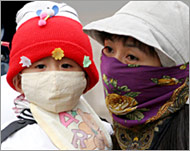Bird flu claims 5th victim in Vietnam
A fifth person has died from bird flu in Vietnam, the World Health Organization has said, as UN experts scoured the country for other suspected cases of the virus that has caused an Asia-wide health scare.

Bob Dietz, the UN health agency’s spokesman in Vietnam, said the latest victim was an eight-year-old girl who died at the Central Paediatric Hospital in Hanoi on Saturday, two days after being admitted.
“This brings the number of confirmed deaths in Vietnam from the H5N1 virus to five,” he told AFP.
However, Dietz said there was no evidence that this latest victim, who first exhibited symptoms of the illness on 11 January, had contracted the disease from another human.
“The source of infection still seems to be coming from poultry. There still does not seem to be human-to-human transmission but we are monitoring the situation very closely,” he said.
The WHO warned over the weekend that a growing number of people had been referred to two hospitals in Hanoi complaining of respiratory illnesses, but said it was too early to say if they were victims of avian influenza.
Pandemic conditions
It has expressed deep concerns about the outbreak, saying it suggests the presence of many conditions that are known to have favoured the start of influenza pandemics in the past.
No confirmed or suspected deaths have been reported in South Korea, Japan and Taiwan, which are all coping with their own bird flu outbreaks.
All the five deaths so far have occurred in northern Vietnam.
Worst affected region
 |
|
The latest victim of the disease |
Two experts from the WHO and the UN Food and Agriculture Organization (FAO) arrived in Ho Chi Minh City on Saturday to hunt for suspected cases of human infection in the south, the worst affected region among poultry.
“We just don’t know why we haven’t heard of any cases from the south. We have sent people there on a joint mission to investigate,” said Dr Peter Horby, the WHO’s Hanoi-based epidemiologist.
“It may simply be a lack of information filtering up the system to us. That is why we have gone to investigate.”
Exact number unclear
The exact number of Vietnam’s 64 provinces and cities affected by the virus remains unclear, but the agriculture ministry officially says eight in the north and seven in the south have reported outbreaks.
About two million chickens have died or have been slaughtered so far, and on UN advice, the government has ordered the culling of all infected and healthy birds in the worst affected regions. It has also banned the sale of poultry in Ho Chi Minh City, its largest metropolis.
|
About two million chickens have died or have been slaughtered so far, and on UN advice, the government has ordered the culling of all infected and healthy birds in the worst affected regions |
However, Anton Rychener, FAO head in Vietnam, said he had grave doubts that the mass cull was actually taking place.
The FAO says it will help pay farmers and chicken owners full compensation for each dead bird. The money will come from the UN agency and the European Commission’s humanitarian fund.
The main facts about the disease:
• What is bird flu?
The outbreaks in South Korea, Japan and Vietnam have been caused by the H5N1 strain of avian influenza viruses. Avian influenza can range from a mild disease that has only minor effects to a highly infectious fatal version. It spreads in the
air and in manure. It can also be transmitted by contaminated feed, water, equipment and clothing. Clinically, normal waterfowl and sea birds may introduce the virus into flocks. Broken contaminated eggs may infect chicks in incubators.
• Is bird flu harmful to humans?
Human fatalities from avian influenza are very rare and were unknown before 1997, when six people in Hong Kong died after being infected with the H5N1 strain. Early last year, a 33-year-old Hong Kong man contracted the H5N1 virus and died of pneumonia. In April 2003, a veterinarian who had been working on a Dutch farm infected with bird flu became ill with an H7 strain of the disease and died of pneumonia. The vet did not take medication against avian and human flu. Rules have been tightened to ensure anyone who comes in contact with infected farms does so.
• Could bird flu become a human epidemic?
Although avian flu is very infectious in birds, it does not spread easily among humans. There is a danger, however, that an avian virus mixes with a human influenza and forms a new disease. The new virus could share genetic material from both viruses, being highly infectious like human flu and dangerously fatal like the avian variety. Humans would have no natural defence against it. New influenza strains have caused pandemics, most recently in 1956-1957 and 1967-1968, killing a combined 4.5 million people.
• Clinical diagnosis
The World Organisation for Animal Health says the incubation period for the disease in poultry is 3-5 days. It has various effects on birds, ranging from drastic declines in egg production to sudden deaths. There is no treatment.